|
About
1980, I discovered an excellent exhibit in the Smithsonian’s National Museum of
American History. It was about the early years of automobile travel and the
resulting development of the tourist home industry in America. It was especially
interesting to me because I was part of the rapidly developing Bed & Breakfast
industry, which was having a rather positive impact on the revitalization of
Cape May’s economy. It also helped me realize the close relationship between
travelers’ needs and interest and the ty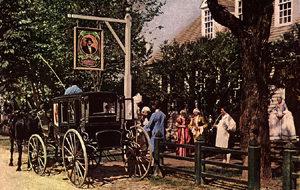 pes of overnight accommodations that
became available for them during the course of America’s history. pes of overnight accommodations that
became available for them during the course of America’s history.
For those of
you who have visited Williamsburg taverns, the guides’ description of colonial
tavern accommodations would make you want to stay home. Besides sharing the
outhouse, one also shared the beds with bundling boards used to separate the
sleepers. Only men “enjoyed” the taverns and plentiful food and liquor probably
helped them collectively snore off the experience. Women travelers needed to
make arrangements with friends or relatives along their travel route to insure
they remained in a more protective environment. As railroad travel developed
through the 19th century, hotels were built in close proximity to
railroad stations and offered a wide variety of accommodations from basic to
very luxu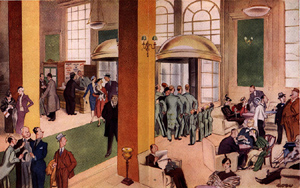 rious. Old movies would give one the impression they were all luxurious,
and most of them that have survived today represent the finest of their time. rious. Old movies would give one the impression they were all luxurious,
and most of them that have survived today represent the finest of their time.
The automobile
changed travel completely, but not immediately. Cars were becoming commonplace
before good road systems connected destinations, but by the 1930s, automobile
road trips were giving the railroads and their hotels serious competition. Cars
allowed travelers to explore places and communities relatively unavailable by
trains and the railroad hotels. With typical Yankee ingenuity, homeowners
started displaying signs offering “Rooms” or “Tourism Accommodations” and
probably offered a wide variety of good and mediocre tra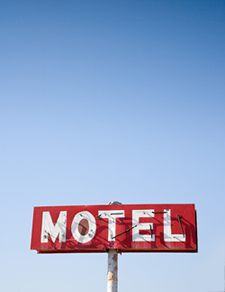 vel experiences. A whole
new industry in America was born, thrived and slowly gave way to the roadside
motel industry of the 1950s. Early motels offered “cabins” and worked hard to
create a residential appearance. But as time moved on, motel chains found that
uniform appearance of their buildings and guest units and proximity from door to
car were very important to the traveler. The term “branding” might not have been
in use but it was sure in practice. vel experiences. A whole
new industry in America was born, thrived and slowly gave way to the roadside
motel industry of the 1950s. Early motels offered “cabins” and worked hard to
create a residential appearance. But as time moved on, motel chains found that
uniform appearance of their buildings and guest units and proximity from door to
car were very important to the traveler. The term “branding” might not have been
in use but it was sure in practice.
My brother and
I grew up with motel travel and, as long as there was a swimming pool, all was
great! But by the time I married Sue in 1968, we agreed that this type of travel
was becoming boring at best.
In our early
travels together to then undiscovered places such as Charleston and Savannah, we
found and enjoyed some of the remaining rooming houses, but recognized they were
rapidly disappearing from America’s landscape. We didn’t realize at
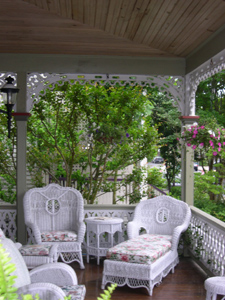 the time,
but we were not the only travelers finding motels tiresome. Americans were weary
of the sterile motel experience and were developing a growing interest in
history travel; the birth of the American B&B experience was just around the
corner. the time,
but we were not the only travelers finding motels tiresome. Americans were weary
of the sterile motel experience and were developing a growing interest in
history travel; the birth of the American B&B experience was just around the
corner.
Cape May also
did not realize it would soon enjoy national recognition not only for its B&B’s
but also for the development of the B&B industry. How did this come to pass?
While Wildwood was booming and building in the 1950s and 60s, Cape May remained
quiet and relatively undiscovered. Several new motels had appeared but historic
hotels and numerous rooming houses dominated the town’s accommodations and their
business season was as short as the summer. As we approached America’s
bicentennial in 1976, a very strong interest developing in using vacations to
discovery our country’s history. Historic communities from Bar Harbor to Key
West enjoyed an influx
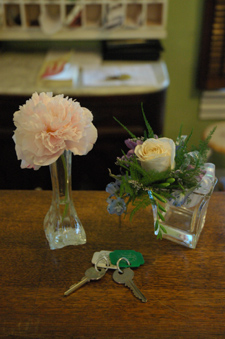 of travelers. Victorian Cape May fell right in the mix
and understood early on that these travelers did not just want to see history,
museum style, but they wanted to stay, dine and shop in historic places. Our
large, rambling Victorian houses were made for B&B conversion with sufficient
space for 5-10 guest rooms, public rooms and verandas and at least one small
back room for the owners. of travelers. Victorian Cape May fell right in the mix
and understood early on that these travelers did not just want to see history,
museum style, but they wanted to stay, dine and shop in historic places. Our
large, rambling Victorian houses were made for B&B conversion with sufficient
space for 5-10 guest rooms, public rooms and verandas and at least one small
back room for the owners.
In 1971 when
Sue and I opened the Mainstay, we were sure there was less than a dozen B&B’s in
America – we only knew of 4 others but did not have the luxury of an Internet
search. Within 20 years, there were approximately 80 in Cape May alone and a
report by PAII, the Professional Association of Innkeepers International,
indicated that the number of B&B inns in the USA exceeded 30,000. Recognizing
the value of our collective experience, Cape May Innkeepers offered to create a
school for perspective innkeepers as a fund-raiser for the Mid-Atlantic Center
for the Arts. Our tongue and cheek name of INN DEEP added to the appeal and we
attracted up to 100 students each year in what use to be called, the “off
season.” Many of our students shared our love for Cape May and decided to end
their search for a great B&B location right here.
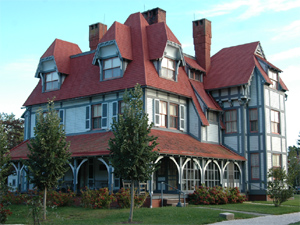 Today if you
enjoyed a horse and carriage tour of Cape May during the summer or the Holly
Trolley Tour of our town all decorated for the Christmas season, it would be
hard to imagine this community in a state of disrepair. The B&B industry has
been given ample credit for helping establish a sound economy for Cape May, but
it has never received proper credit for its role in historic preservation in
Cape May or in much of America. By the late 1960’s, Cape May’s Historic District
was in sad shape. The Physick Estate was abandoned and over grown, empty
storefronts were plentiful on Washington Street before the Mall, and several of
our famous old hotels and homes were preparing for the wrecking ball. But by
1976, Cape May was awarded National Historic Landmark status and B&B owners were
involved in all aspects of the community rebirth. One by one, residences that
had escaped attention for many years found dedicated new owners for B&B
conversion. Inappropriate white paint gave way to Victorian colors, remodeled
exteriors were res Today if you
enjoyed a horse and carriage tour of Cape May during the summer or the Holly
Trolley Tour of our town all decorated for the Christmas season, it would be
hard to imagine this community in a state of disrepair. The B&B industry has
been given ample credit for helping establish a sound economy for Cape May, but
it has never received proper credit for its role in historic preservation in
Cape May or in much of America. By the late 1960’s, Cape May’s Historic District
was in sad shape. The Physick Estate was abandoned and over grown, empty
storefronts were plentiful on Washington Street before the Mall, and several of
our famous old hotels and homes were preparing for the wrecking ball. But by
1976, Cape May was awarded National Historic Landmark status and B&B owners were
involved in all aspects of the community rebirth. One by one, residences that
had escaped attention for many years found dedicated new owners for B&B
conversion. Inappropriate white paint gave way to Victorian colors, remodeled
exteriors were res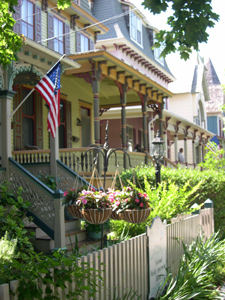 tored with the help of old photographs, antiques returned to
Cape May rather than departed, and front porches enjoyed the social life they
had missed for many years. Rocking on a veranda, enjoying breakfast or afternoon
tea and watching people watching you became headlines in travel literature as it
sang the praises of B&B’s in Victorian Cape May. It was a historic preservation
dream come true. tored with the help of old photographs, antiques returned to
Cape May rather than departed, and front porches enjoyed the social life they
had missed for many years. Rocking on a veranda, enjoying breakfast or afternoon
tea and watching people watching you became headlines in travel literature as it
sang the praises of B&B’s in Victorian Cape May. It was a historic preservation
dream come true.
I am often
asked if I miss innkeeping. While retirement has provided time for other
interests and travel, the time spent helping visitors enjoy our history and our
wonderful community were truly some of my favorite moments in life so far. The
interaction of innkeepers and guests is as old as recorded history and still as
valuable to both. Would I do it all over? You bet!
Ten most important considerations for new
innkeepers
So you think you might want to buy a B&B and become an
innkeeper? We polled a few of Cape May’s finest innkeepers and here’s some
“considerations” they come up with:
 Location,
location, location, just as they teach at Cornell. Does the considered location
attract the B&B crowd? This cliental is usually educated, middle to upper
income, sophisticated, interested in cultural and environment activities, and
enjoy good food and very attractive accommodations. Are you in or near major
tourist attractions, colleges, corporate business offices, hospitals,
courthouses, etc. - Tom Carroll, former innkeeper of the Mainstay Location,
location, location, just as they teach at Cornell. Does the considered location
attract the B&B crowd? This cliental is usually educated, middle to upper
income, sophisticated, interested in cultural and environment activities, and
enjoy good food and very attractive accommodations. Are you in or near major
tourist attractions, colleges, corporate business offices, hospitals,
courthouses, etc. - Tom Carroll, former innkeeper of the Mainstay
 Inns in
Cape May are fortunate that Cape May and the Jersey shore in general are within
driving distance of millions of people from so many major metropolitan areas.
Being in an area that is a destination itself, makes marketing much easier than
having to make your inn the reason for travel to a more remote location. Inns in
Cape May are fortunate that Cape May and the Jersey shore in general are within
driving distance of millions of people from so many major metropolitan areas.
Being in an area that is a destination itself, makes marketing much easier than
having to make your inn the reason for travel to a more remote location.
 Is your
business plan realistic? You should take your estimated start-up cost and see if
you could afford to add 25 to 40 percent to it if you had too. Is your
business plan realistic? You should take your estimated start-up cost and see if
you could afford to add 25 to 40 percent to it if you had too.
 Do you or
your partners have the right personality to be “on stage” much of the day? Would
you find all this social time enjoyable or would it and the long hours grow old
very fast? Do you or
your partners have the right personality to be “on stage” much of the day? Would
you find all this social time enjoyable or would it and the long hours grow old
very fast?
 Truly being
a "people person" is an important consideration for a potential innkeeper. You
will get asked the same questions many times and have your personal time and
space invaded. Being able to remain friendly and helpful at these times is so
important. If you read comments guests make about their visits, you will notice
that there are more comments about how guests felt they were treated than the
facility itself. Truly being
a "people person" is an important consideration for a potential innkeeper. You
will get asked the same questions many times and have your personal time and
space invaded. Being able to remain friendly and helpful at these times is so
important. If you read comments guests make about their visits, you will notice
that there are more comments about how guests felt they were treated than the
facility itself.
 Do you and
your partners have a plan for a fair division of responsibilities that match
your talents and interest? This should be a long, sober, serious discussion
before any decision is concluded. It should become part of a business contract,
not unlike a marriage contract. Running an inn together and being married to a
partner have very close parallels. Do you and
your partners have a plan for a fair division of responsibilities that match
your talents and interest? This should be a long, sober, serious discussion
before any decision is concluded. It should become part of a business contract,
not unlike a marriage contract. Running an inn together and being married to a
partner have very close parallels.
 Be able to
perform all tasks associated with innkeeping. As with any small business,
finding and keeping good help can be hard. Even if cooking is your
responsibility, you will probably need to clean and make beds when the help
doesn’t show up. Be able to
perform all tasks associated with innkeeping. As with any small business,
finding and keeping good help can be hard. Even if cooking is your
responsibility, you will probably need to clean and make beds when the help
doesn’t show up.
 Don’t think
occupancy rate – think bottom line. If you are renting a room for $50 a night
and are at full occupancy, that does not mean you are making money, as you will
find out come December 31. Don’t think
occupancy rate – think bottom line. If you are renting a room for $50 a night
and are at full occupancy, that does not mean you are making money, as you will
find out come December 31.
 Work toward developing repeat customers. Guests who become part of your "family" will return
many times and spread the word to their friends and family. I have one couple
who have stayed with me 30 times in the 7 years that I have been here. I love it
when the phone rings and the caller says they were referred to me by a regular
customer. - Alison Bjork, White Dove Cottage. Work toward developing repeat customers. Guests who become part of your "family" will return
many times and spread the word to their friends and family. I have one couple
who have stayed with me 30 times in the 7 years that I have been here. I love it
when the phone rings and the caller says they were referred to me by a regular
customer. - Alison Bjork, White Dove Cottage.
 Remember the
days when you worked for someone, like IBM for example, and payday was a happy
and regular happening? That’s not necessarily how it works when you are an
innkeeper and you are self-employed. Part of your paycheck is the lifestyle you
traded for getting out of the “rat race.” So, don’t worry. Be happy. Remember the
days when you worked for someone, like IBM for example, and payday was a happy
and regular happening? That’s not necessarily how it works when you are an
innkeeper and you are self-employed. Part of your paycheck is the lifestyle you
traded for getting out of the “rat race.” So, don’t worry. Be happy.
 Tom Carroll and
his wife Sue retired from 34 years on innkeeping in 2004. They remain busy with
Restoration & Innovation Consulting helping others with projects large and
small. They still enjoy being involved in projects without physically doing all
the work. Tom Carroll and
his wife Sue retired from 34 years on innkeeping in 2004. They remain busy with
Restoration & Innovation Consulting helping others with projects large and
small. They still enjoy being involved in projects without physically doing all
the work. |
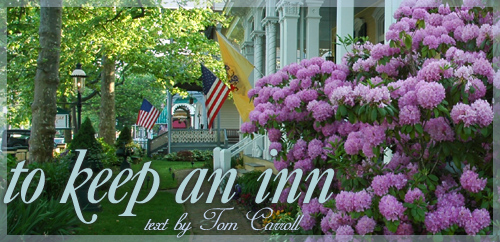
 pes of overnight accommodations that
became available for them during the course of America’s history.
pes of overnight accommodations that
became available for them during the course of America’s history. rious. Old movies would give one the impression they were all luxurious,
and most of them that have survived today represent the finest of their time.
rious. Old movies would give one the impression they were all luxurious,
and most of them that have survived today represent the finest of their time.
 vel experiences. A whole
new industry in America was born, thrived and slowly gave way to the roadside
motel industry of the 1950s. Early motels offered “cabins” and worked hard to
create a residential appearance. But as time moved on, motel chains found that
uniform appearance of their buildings and guest units and proximity from door to
car were very important to the traveler. The term “branding” might not have been
in use but it was sure in practice.
vel experiences. A whole
new industry in America was born, thrived and slowly gave way to the roadside
motel industry of the 1950s. Early motels offered “cabins” and worked hard to
create a residential appearance. But as time moved on, motel chains found that
uniform appearance of their buildings and guest units and proximity from door to
car were very important to the traveler. The term “branding” might not have been
in use but it was sure in practice. the time,
but we were not the only travelers finding motels tiresome. Americans were weary
of the sterile motel experience and were developing a growing interest in
history travel; the birth of the American B&B experience was just around the
corner.
the time,
but we were not the only travelers finding motels tiresome. Americans were weary
of the sterile motel experience and were developing a growing interest in
history travel; the birth of the American B&B experience was just around the
corner. of travelers. Victorian Cape May fell right in the mix
and understood early on that these travelers did not just want to see history,
museum style, but they wanted to stay, dine and shop in historic places. Our
large, rambling Victorian houses were made for B&B conversion with sufficient
space for 5-10 guest rooms, public rooms and verandas and at least one small
back room for the owners.
of travelers. Victorian Cape May fell right in the mix
and understood early on that these travelers did not just want to see history,
museum style, but they wanted to stay, dine and shop in historic places. Our
large, rambling Victorian houses were made for B&B conversion with sufficient
space for 5-10 guest rooms, public rooms and verandas and at least one small
back room for the owners. Today if you
enjoyed a horse and carriage tour of Cape May during the summer or the Holly
Trolley Tour of our town all decorated for the Christmas season, it would be
hard to imagine this community in a state of disrepair. The B&B industry has
been given ample credit for helping establish a sound economy for Cape May, but
it has never received proper credit for its role in historic preservation in
Cape May or in much of America. By the late 1960’s, Cape May’s Historic District
was in sad shape. The Physick Estate was abandoned and over grown, empty
storefronts were plentiful on Washington Street before the Mall, and several of
our famous old hotels and homes were preparing for the wrecking ball. But by
1976, Cape May was awarded National Historic Landmark status and B&B owners were
involved in all aspects of the community rebirth. One by one, residences that
had escaped attention for many years found dedicated new owners for B&B
conversion. Inappropriate white paint gave way to Victorian colors, remodeled
exteriors were res
Today if you
enjoyed a horse and carriage tour of Cape May during the summer or the Holly
Trolley Tour of our town all decorated for the Christmas season, it would be
hard to imagine this community in a state of disrepair. The B&B industry has
been given ample credit for helping establish a sound economy for Cape May, but
it has never received proper credit for its role in historic preservation in
Cape May or in much of America. By the late 1960’s, Cape May’s Historic District
was in sad shape. The Physick Estate was abandoned and over grown, empty
storefronts were plentiful on Washington Street before the Mall, and several of
our famous old hotels and homes were preparing for the wrecking ball. But by
1976, Cape May was awarded National Historic Landmark status and B&B owners were
involved in all aspects of the community rebirth. One by one, residences that
had escaped attention for many years found dedicated new owners for B&B
conversion. Inappropriate white paint gave way to Victorian colors, remodeled
exteriors were res tored with the help of old photographs, antiques returned to
Cape May rather than departed, and front porches enjoyed the social life they
had missed for many years. Rocking on a veranda, enjoying breakfast or afternoon
tea and watching people watching you became headlines in travel literature as it
sang the praises of B&B’s in Victorian Cape May. It was a historic preservation
dream come true.
tored with the help of old photographs, antiques returned to
Cape May rather than departed, and front porches enjoyed the social life they
had missed for many years. Rocking on a veranda, enjoying breakfast or afternoon
tea and watching people watching you became headlines in travel literature as it
sang the praises of B&B’s in Victorian Cape May. It was a historic preservation
dream come true. Location,
location, location, just as they teach at Cornell. Does the considered location
attract the B&B crowd? This cliental is usually educated, middle to upper
income, sophisticated, interested in cultural and environment activities, and
enjoy good food and very attractive accommodations. Are you in or near major
tourist attractions, colleges, corporate business offices, hospitals,
courthouses, etc. - Tom Carroll, former innkeeper of the Mainstay
Location,
location, location, just as they teach at Cornell. Does the considered location
attract the B&B crowd? This cliental is usually educated, middle to upper
income, sophisticated, interested in cultural and environment activities, and
enjoy good food and very attractive accommodations. Are you in or near major
tourist attractions, colleges, corporate business offices, hospitals,
courthouses, etc. - Tom Carroll, former innkeeper of the Mainstay  Inns in
Cape May are fortunate that Cape May and the Jersey shore in general are within
driving distance of millions of people from so many major metropolitan areas.
Being in an area that is a destination itself, makes marketing much easier than
having to make your inn the reason for travel to a more remote location.
Inns in
Cape May are fortunate that Cape May and the Jersey shore in general are within
driving distance of millions of people from so many major metropolitan areas.
Being in an area that is a destination itself, makes marketing much easier than
having to make your inn the reason for travel to a more remote location. Is your
business plan realistic? You should take your estimated start-up cost and see if
you could afford to add 25 to 40 percent to it if you had too.
Is your
business plan realistic? You should take your estimated start-up cost and see if
you could afford to add 25 to 40 percent to it if you had too. Do you or
your partners have the right personality to be “on stage” much of the day? Would
you find all this social time enjoyable or would it and the long hours grow old
very fast?
Do you or
your partners have the right personality to be “on stage” much of the day? Would
you find all this social time enjoyable or would it and the long hours grow old
very fast? Truly being
a "people person" is an important consideration for a potential innkeeper. You
will get asked the same questions many times and have your personal time and
space invaded. Being able to remain friendly and helpful at these times is so
important. If you read comments guests make about their visits, you will notice
that there are more comments about how guests felt they were treated than the
facility itself.
Truly being
a "people person" is an important consideration for a potential innkeeper. You
will get asked the same questions many times and have your personal time and
space invaded. Being able to remain friendly and helpful at these times is so
important. If you read comments guests make about their visits, you will notice
that there are more comments about how guests felt they were treated than the
facility itself. Do you and
your partners have a plan for a fair division of responsibilities that match
your talents and interest? This should be a long, sober, serious discussion
before any decision is concluded. It should become part of a business contract,
not unlike a marriage contract. Running an inn together and being married to a
partner have very close parallels.
Do you and
your partners have a plan for a fair division of responsibilities that match
your talents and interest? This should be a long, sober, serious discussion
before any decision is concluded. It should become part of a business contract,
not unlike a marriage contract. Running an inn together and being married to a
partner have very close parallels. Be able to
perform all tasks associated with innkeeping. As with any small business,
finding and keeping good help can be hard. Even if cooking is your
responsibility, you will probably need to clean and make beds when the help
doesn’t show up.
Be able to
perform all tasks associated with innkeeping. As with any small business,
finding and keeping good help can be hard. Even if cooking is your
responsibility, you will probably need to clean and make beds when the help
doesn’t show up. Don’t think
occupancy rate – think bottom line. If you are renting a room for $50 a night
and are at full occupancy, that does not mean you are making money, as you will
find out come December 31.
Don’t think
occupancy rate – think bottom line. If you are renting a room for $50 a night
and are at full occupancy, that does not mean you are making money, as you will
find out come December 31. Work toward developing repeat customers. Guests who become part of your "family" will return
many times and spread the word to their friends and family. I have one couple
who have stayed with me 30 times in the 7 years that I have been here. I love it
when the phone rings and the caller says they were referred to me by a regular
customer. - Alison Bjork, White Dove Cottage.
Work toward developing repeat customers. Guests who become part of your "family" will return
many times and spread the word to their friends and family. I have one couple
who have stayed with me 30 times in the 7 years that I have been here. I love it
when the phone rings and the caller says they were referred to me by a regular
customer. - Alison Bjork, White Dove Cottage. Remember the
days when you worked for someone, like IBM for example, and payday was a happy
and regular happening? That’s not necessarily how it works when you are an
innkeeper and you are self-employed. Part of your paycheck is the lifestyle you
traded for getting out of the “rat race.” So, don’t worry. Be happy.
Remember the
days when you worked for someone, like IBM for example, and payday was a happy
and regular happening? That’s not necessarily how it works when you are an
innkeeper and you are self-employed. Part of your paycheck is the lifestyle you
traded for getting out of the “rat race.” So, don’t worry. Be happy. Tom Carroll and
his wife Sue retired from 34 years on innkeeping in 2004. They remain busy with
Restoration & Innovation Consulting helping others with projects large and
small. They still enjoy being involved in projects without physically doing all
the work.
Tom Carroll and
his wife Sue retired from 34 years on innkeeping in 2004. They remain busy with
Restoration & Innovation Consulting helping others with projects large and
small. They still enjoy being involved in projects without physically doing all
the work.